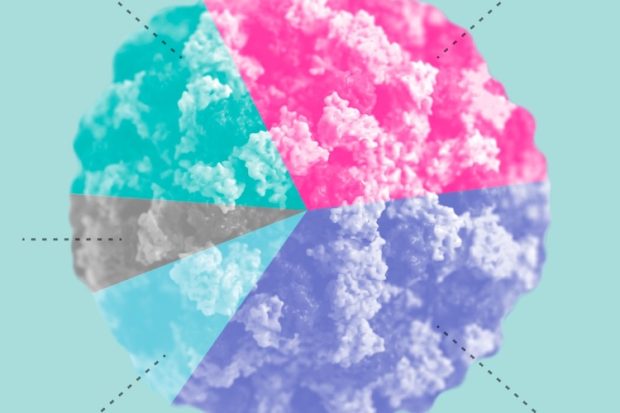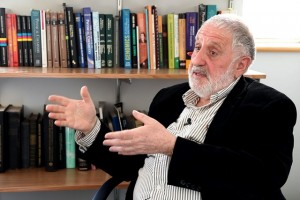Genome Medicine
Bioinformatician Tim Hubbard on the ‘100,000 Genomes Project’, how to use genome data in diagnostics and treat...

In September Physical Review X published an article called “Control of Stochastic and Induced Switching in Biophysical Networks.” We asked one of the authors, Daniel Wells from the Northwestern University, to comment on this study.
One of the most important discoveries in biology in the past 20 years is just how random life is at the cellular level. Due to intrinsic biochemical signaling noise and slight changes to external conditions, the expression levels of different genes are constantly fluctuating in time. These fluctuations, coupled with the nonlinearity and interconnectedness of gene regulatory networks, can occasionally be large enough to cause the entire phenotype of a cell to change spontaneously. Such noise-induced transitions in gene expression can create havoc inside of a cell, going so far as to drive it to transition to a potentially unhealthy phenotype. However, until now, no broadly-applicable method existed to identify how to intervene within a gene regulatory network to control how it responds to noise.
To address this we developed a computational method to analyze mathematical models of gene regulatory networks and identify interventions that will change how that network responds to noise in a desired way. This method relies on a mathematical tool called the Freidiln-Wentzell action. By minimizing this action over all paths connecting two states in gene expression space, we can calculate the approximate transition rates between any pair of gene expression states. In turn, we can use these transition rates to connect different gene expression states together into a network of state transitions. The crucial insight from our work is that the transition dynamics of this subsidiary network are much easier to control than the noisy dynamics of the high-dimensional gene regulatory network, and yet the outcome of both forms of control is nearly identical. This is really important in our case, since it allows our method to be applicable to really large regulatory networks without undue computational burden.

Once we had our method working, we applied it to a large, gene regulatory network: the cell death pathway, with states representing healthy cell death (apoptosis) and unhealthy cell proliferation, which is linked to the emergence of cancer. Our goal was to identify an intervention that would eliminate the proliferative state. While the initial application of our method was successful in this aim, the intervention it found required directly altering the networks in dozens of different places in the network to be successful. Any such intervention would be doomed to fail in a biological setting, where we can typically only modify at most a few different parameters at once. To overcome this, we leveraged tools from the machine learning field of sparse optimization to identify the control variables which were the most important to eliminating the unhealthy cell state. By doing so we found successful interventions that used only 5% of the control set. Interestingly, while some of the targets we identified are well known therapeutic targets (e.g., NFkB), others that were as strongly implicated by our method are not, and these could be potentially promising targets for future therapies. This work demonstrates how noise in biological systems, far from being a nuisance, can be leveraged to achieve robust network control.
Networks are a ubiquitous part of our lives, from Facebook and the World Wide Web down to the set of thousands of co-regulating genes that are encoded within the DNA of each cell in our bodies. Far from being static objects, these networks typically have dynamical behavior, meaning that the activity levels of different nodes change over time. A growing and extremely important area in network science is the concept of network control: essentially, how can we control the dynamics of a large, interconnected network to achieve desired outcomes? An immense amount of work has built robust methodologies for linear systems with minimal noise, and more recently, methodologies have been developed to control nonlinear network dynamics as well. These methods are very different: in general, nonlinear networks, like gene regulatory networks, will have multiple different attractors – low dimensional places, like fixed points, where the system will spend most of its time. Such multistability, the property of having many different attractors, does not exist in linear systems.
In all of these methods, however, a crucial component is missing: noise. This is especially true in biological systems, like gene regulatory networks, where noise is known to play an extremely important role in gene regulation and cell fate. Thus, methods that do not take noise into account are at best less effective than they could be, and at worst will not work when applied to models incorporating noise. When we initially began working on this project very few people were thinking about noise in networks, and even fewer that noise could be used as a tool to achieve control.
In our paper we applied the method we developed primarily to biological systems, but the method is more general than that. Really, it can be applied to any network dynamical system that has multiple attractors and where one seeks to control the response to noise. Thus, the realm of applications for the method is quite broad. One can imagine using the method to identify how to prevent extinction cascades in ecosystems, or prevent blackouts in power grids. So we are particularly interested in applying the method to other systems to see what we can learn there.

Bioinformatician Tim Hubbard on the ‘100,000 Genomes Project’, how to use genome data in diagnostics and treat...

Boston University Professor Maxim Frank-Kamenetskii on the double helix structure of DNA, formaldehyde reactiv...

Neuroscientist Mark Mattson on tau proteins, free radicals, and the importance of exercise in maintaining cogn...